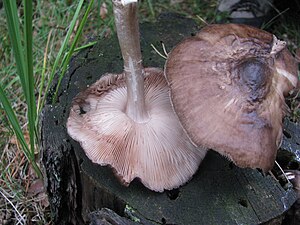Black-edged roof fungus
| Black-edged roof fungus | ||||||||||||
|---|---|---|---|---|---|---|---|---|---|---|---|---|

Black- edged badger ( Pluteus nigrofloccosus ) |
||||||||||||
| Systematics | ||||||||||||
|
||||||||||||
| Scientific name | ||||||||||||
| Pluteus nigrofloccosus | ||||||||||||
| Favre |
The black- edged roof fungus ( Pluteus nigrofloccosus , syn. P. atromarginatus ) is a wood-dwelling fungus from the genus of the roof fungus . It occurs in temperate Eurasia and North America , where it attacks conifers . It prefers moist and fresh soil and is used as an edible mushroom .
features
Macroscopic features
The black-edged roof fungus forms typical agaric fruit bodies, which appear singly or gregarious to almost tufted. The hat is about 4–8 cm wide, its surface is dark brown to smoky black, with black flakes in the middle. It is velvety matt and not rubbed, when it is damp it feels greasy. The hat is initially conical to hemispherical, later convex to expanded with a blunt hump. The stalk becomes 3–6 cm long and 4–10 mm thick, it is covered on a whitish ground with adjacent gray-brown fibers to ocher-brownish, it is full, brittle, somewhat thickened at the base and slightly clubbed. The wide lamellae, which are free at the stem, are crowded and mixed in, they are initially whitish, later turning brownish-pink through shades of pink, the dark edge is characteristic. The flesh of the hat is gray-brown under the hat skin, thicker in the middle of the hat, thinning towards the edge, it has no particular smell or taste.
Microscopic features
The black-edged roof fungus has broadly elliptical, smooth, pink-brown spores that are approx. 6–7.5 µm long and 4–5 µm wide. The basidia are clubbed to bulbous in shape, have four spores and there are occasional basal buckles. They become 22–35 µm long and 11–30 µm wide. Club-bellied 25–80 × 11–30 µm large, brown-pigmented cheilocystidia and thick-walled pleurocystidia, usually with 2–3 hooks at the tip, are found. The top layer of hat skin consists of parallel, brown-pigmented hyphae 6–15 µm wide with protruding, spindle-shaped hyphae ends 70–185 µm long and 8–30 µm thick. Most of the septa , in contrast to the closely related fawn roof mushroom ( Pluteus cervinus ), have buckles.
ecology
The black-edged roof fungus occurs in forests, but is not tied to certain forest types, it also prefers fresh to moist soils, but otherwise makes no special demands on the soil type. The main substrate in Central Europe is wood from the common spruce , as well as silver fir and Scots pine . He apparently benefited from the forest expansion there of the pine and spruce. The fruiting bodies appear in Central Europe from late May to early November.
distribution
The black-edged roof fungus occurs in the entire Holarctic from the meridonal to the boreal zones. In Northern Europe it is found up to the 61st, in Finland also up to the 68th parallel. In Germany, the black-edged roof fungus occurs in the entire area, but is very patchy in the northern lowlands. Its occurrences are becoming increasingly dense in the southern parts of Germany, south of the Main it is locally widespread to common.
meaning
The black-edged roof mushroom is used as an edible mushroom.
swell
- E. Gerhardt: The great BLV mushroom guide for on the go. BLV Verlagsgesellschaft mbH, Munich, Vienna, Zurich 2001; ISBN 3-405-15147-3
- Josef Breitenbach, Fred Kränzlin (Ed.): Mushrooms of Switzerland. Contribution to knowledge of the fungal flora in Switzerland. Volume 4: Agarics. Part 2: Entolomataceae, Pluteaceae, Amanitaceae, Agaricaceae, Coprinaceae, Bolbitiaceae, Strophariaceae. Mykologia, Luzern 1995, ISBN 3-85604-040-4 .
- German Josef Krieglsteiner (Ed.), Andreas Gminder : Die Großpilze Baden-Württemberg . Volume 4: Mushrooms. Blattpilze II. Ulmer, Stuttgart 2003, ISBN 3-8001-3281-8 .